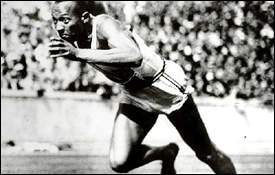Driving through South
Phoenix, a centralized section of new development surrounds
Jesse Owens Avenue. At first glance, I recall the familiarity of the name
Jesse Owen and his name conjures image of the Olympics. Upon second
glance, I wonder what is the connection between Jesse Owens and South
Phoenix.
James Cleveland Owens,
better known as Jesse Owens, was the first American-African Olympic Gold
Medalist. Jesse was born in Alabama in 1913 and grew up in Cleveland,
Ohio. He attended the University of Ohio State on a full scholarship
after his high school coach, Charlie Riley, instantly recognized him as a
superior running talent and placed him on the high-school track team. At
Ohio State University in 1935, Jesse struggled with segregation and open
racism as he traveled with the track team throughout the Midwest. In Ann
Arbor, Michigan, at a track meet on May 25, 1935, Jesse set three world
records and tied for a fourth. He accomplished this while suffering from
injuries resulting from a fall down stairs the day before.
 In the 1936 Olympics,
dubbed the “Hitler Olympics,” Jesse won four gold medals. Jesse is the
first American to ever win four gold medals in the Track and Field events
in a single Olympics. He was awarded gold medals in the 100-meter dash,
the 200-meter dash, the broad jump and as a member of the 400-meter relay
team.
In the 1936 Olympics,
dubbed the “Hitler Olympics,” Jesse won four gold medals. Jesse is the
first American to ever win four gold medals in the Track and Field events
in a single Olympics. He was awarded gold medals in the 100-meter dash,
the 200-meter dash, the broad jump and as a member of the 400-meter relay
team.
Even with Jesse’s
amazing performance at the 1936 Olympics, he was never offered any
endorsements. Due to financial restrictions, Jesse left the University of
Ohio during his junior year to pursue a professional running career. As
he traveled to different running engagements, Jesse was often asked to
speak to regarding his experience at the Olympics. Jesse became an
articulate and enjoyable lecturer on athletics and the importance of
religion, hard work and loyalty. Eventually, he started his own public
relations firm and spoke on behalf of world-known entities such as Ford
Motor Company and the United States Olympic Committee. He served as
Secretary of the Illinois State Athletic Commission. He also made
goodwill visits to India and the Far East for the State Department and
sponsored youth sports programs for underprivileged neighborhoods along
with many other community events. Mr. Owens understood that the effect of
segregation on black well-being was structural and not individual as
Massey and Denton wrote in American Apartheid: Segregation and the
Making of the Underclass (1993). As Massey and Denton point out, it
is important to recognize that although today it is widely believed that
segregation is part of America's past, the presence of structural
segregation is alive throughout our cities.
In 1976, Jesse was
awarded the Medal of Freedom by Gerald R. Ford, the highest honor an
American civilian can receive.
In 1980, Jesse Owens
died at the age of sixty-six in Tucson, Arizona. Even after Jesse’s
death, he continues to be recognized for his lasting achievements. In
March of 1990, then-President George Bush, presented Jesse Owens with the
Congressional Gold Medal, which was accepted by Mrs. Jesse Owens. In
honor of Jesse Owens, his family constructed The Jesse Owens Foundation, a
non-profit organization that provides support to youth development,
promoting youth to reach their fullest potential through the Ruth and
Jesse Owens Scholars Program.
Yet, what is still not
apparent, is Jesse’s connection to South Phoenix. It is not common
knowledge why a large thoroughfare and an Urgent Care Center bear his name
in South Phoenix.
To answer this
question, I contacted by email, the Jesse Owens Foundation in hopes that I
could discover Mr. Owens’ link to Phoenix, Arizona. I was surprised when
Mr. Owens’ eldest daughter, Marlene Owens Rankin, wrote back and explained
that her father lived in Phoenix from 1972 until his death in 1980. Mr.
Owens was first hospitalized at Good Samaritan Hospital during his
illness, but primarily treated at a Tucson hospital, where he died. Jesse
Owens served on the board of Phoenix Memorial Hospital when the medical
center was first established to service the residents of South Phoenix.
The medical facility was named for Jesse Owens, along with the street
adjacent to the medical center. Before being flown to Chicago for funeral
services and burial, Jesse Owens lay in ceremony in the Arizona State
Capital rotunda in Phoenix where thousands came to pay their respects.
Ms. Owens Rankin assured me that this is her father’s Arizona history, as
she lived it (Owens Rankin, 2004).
South Phoenix also
holds an 8-kilometer run/walk and other fundraising events to support
community efforts in remembrance of the great humanitarian.
Jesse Owens will
always be remembered as an extraordinary athlete and an extraordinary
person, one who was caring, compassionate and giving. He will always hold
the hearts of the South Phoenix and metropolitan Phoenix residents.
Follow the links for more information about
Jesse Owens and the
Medal of Freedom.

